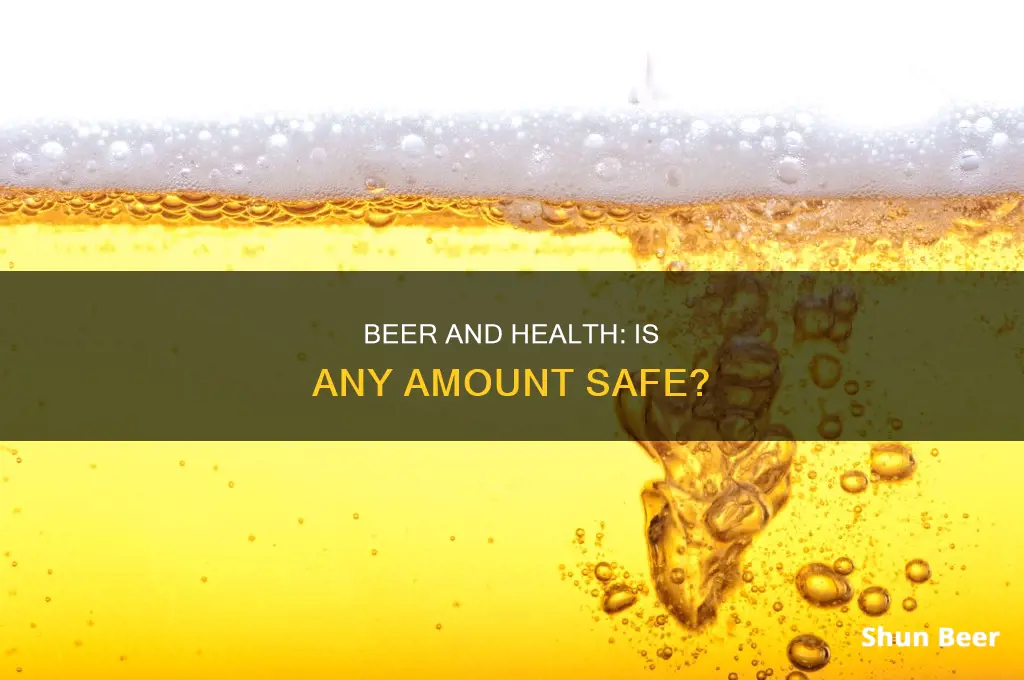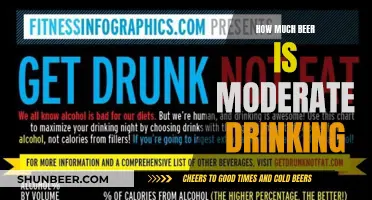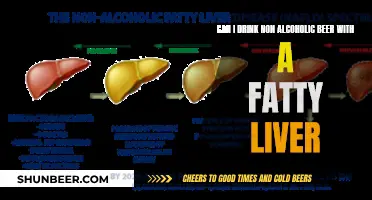
Alcohol is a drug, and drinking even a little beer can be harmful to one's health. Alcohol is a toxic, psychoactive, and dependence-producing substance, and has been classified as a Group 1 carcinogen. Research has shown that excessive alcohol use can lead to acute issues like accidents, poisonings, and homicides, as well as chronic conditions like liver disease, cancer, and heart disease. Even moderate consumption can have health consequences, and the World Health Organization has stated that there is no safe amount of alcohol that does not affect one's health. The effects of alcohol vary from person to person, but factors such as age, weight, sex, body water composition, enzyme production, and medications can influence how much alcohol a person can withstand. While the liver can process about one standard drink per hour, drinking too much too quickly can lead to alcohol poisoning, which can be life-threatening. To minimize health risks, it is recommended to limit alcohol consumption to low-risk levels, spread drinking over multiple days, and have several drink-free days each week.
| Characteristics | Values |
|---|---|
| Amount of alcohol considered "low risk" | 14 units of alcohol per week |
| Amount of alcohol considered "heavy" or "at-risk" drinking | More than 14 units of alcohol per week |
| Amount of alcohol that can be processed by the body per hour | 1 unit of alcohol |
| Amount of alcohol that can be processed by the liver per hour | 1 standard drink |
| Blood alcohol concentration (BAC) considered dangerous | 0.40% or over |
| BAC at which a person is legally considered intoxicated | 0.08% |
| Standard drink | 12 oz of beer (5% alcohol), 5 oz of wine (12% alcohol), or 1.5 oz of distilled spirits |
| Alcohol-related cancers | Mouth, throat, bowel, breast |
| Other alcohol-related health issues | Damage to the nervous system, mental health issues, self-harm, stroke, liver disease, heart disease |
| Groups at higher risk of alcohol-related harm | Disadvantaged and vulnerable populations, pregnant or planning to become pregnant, those taking medications that interact with alcohol, those with medical conditions that alcohol can worsen |
What You'll Learn

Beer and cancer
The World Health Organization (WHO) has stated that there is no safe amount of alcohol consumption that does not affect health. Alcohol is a toxic, psychoactive, and dependence-producing substance and has been classified as a Group 1 carcinogen, the highest-risk group, by the International Agency for Research on Cancer. This means that any type of alcoholic beverage, including beer, can increase the risk of developing cancer.
When you drink alcohol, your body breaks it down into a chemical that damages your DNA. This damage can cause cells to grow out of control and become cancerous. Alcohol is also broken down into acetaldehyde, a toxic chemical and probable human carcinogen, during metabolism. Additionally, alcohol can generate reactive oxygen species, which can damage DNA, proteins, and lipids in the body through oxidation.
Types of Cancers Associated with Alcohol Consumption
Drinking alcohol is linked to an increased risk of several types of cancer, including:
- Head and neck cancer: Moderate to heavy alcohol consumption increases the risk of oral cavity, pharynx (throat), and larynx (voice box) cancers.
- Esophageal cancer: Any level of alcohol consumption is associated with an increased risk of esophageal squamous cell carcinoma.
- Liver cancer: Heavy alcohol consumption is linked to approximately a two-fold increased risk of hepatocellular carcinoma and intrahepatic cholangiocarcinoma.
- Breast cancer: Increasing alcohol intake is associated with a higher risk of breast cancer, with light drinkers having a slightly increased risk compared to non-drinkers, and the risk increasing further for moderate and heavy drinkers.
- Colorectal cancer: Moderate to heavy alcohol consumption is associated with an increased risk of cancers of the colon and rectum.
- Pancreatic cancer: Drinking three or more alcoholic drinks per day increases the risk of pancreatic cancer.
- Stomach cancer: Drinking about 3.5 drinks per day increases the risk of colorectal cancer.
Reducing Cancer Risk
The best way to reduce the risk of cancer is to limit alcohol consumption or abstain from drinking altogether. Canada's Guidance on Alcohol and Health recommends no more than two standard drinks per week to keep the cancer risk as low as possible. The less alcohol consumed, including beer, the lower the cancer risk.
Shingles and Beer: A Safe Mix?
You may want to see also

Alcohol poisoning
According to the World Health Organization, there is no safe amount of alcohol consumption that does not affect health. Alcohol is a toxic, psychoactive, and dependence-producing substance, and any amount of alcohol consumption can be harmful. The effects of alcohol on an individual depend on various factors, such as age, gender, tolerance, speed of drinking, medications, and the amount of food eaten.
If you suspect someone is experiencing alcohol poisoning, it is important to act quickly and call for emergency medical help. Do not leave the person alone, as they are at risk of injury from falling or choking. Keep them on the ground in a sitting or partially upright position. If they are vomiting, help them lean forward to prevent choking. If they are unconscious or lying down, roll them onto their side with an ear toward the ground. Be prepared to provide information to medical responders, including the type and amount of alcohol consumed, any drugs taken, and any known health information.
To reduce the risk of alcohol poisoning, it is important to drink in moderation and follow low-risk drinking guidelines. The National Health Service (NHS) in the UK recommends that men and women drink no more than 14 units of alcohol per week on a regular basis. To keep within the low-risk category, it is advised to spread your drinking over three or more days and have several drink-free days each week.
The Magic Inside Beer Cartridges: How Do They Work?
You may want to see also

Mental health
Even small amounts of alcohol can have consequences for your mental health. Alcohol is a depressant, which can disrupt the balance of neurotransmitters in your brain and affect your feelings, thoughts, and behaviour.
Alcohol affects the part of your brain that controls inhibition, so you may feel relaxed, less anxious, and more confident after drinking. However, once the alcohol wears off, you may experience negative feelings, such as anger, depression, or anxiety, regardless of your previous mood. This is because alcohol withdrawal affects your brain and body.
Drinking can also increase your risk of developing mental illnesses, such as depression or anxiety. Alcohol increases the risk of suicide, as it lowers inhibitions and can lead to more impulsive behaviour. Research has shown that people with severe mental illness are more likely to have alcohol problems, possibly because they 'self-medicate' by drinking to deal with difficult feelings or symptoms.
In addition, the smell of beer may serve as a relapse trigger for people recovering from alcohol use disorder. According to statistics from the National Institute on Alcohol Abuse and Alcoholism, as many as 90% of alcoholics will experience a relapse within the four years after they quit drinking.
If you are worried about the effects of alcohol on your mental health, it is recommended to speak with your doctor or find local support services.
Drinking NA Beer: Safe Driving or Legal Trouble?
You may want to see also

Liver damage
Alcohol is a toxic, psychoactive, and dependence-producing substance. It is the alcohol that causes harm, not the beverage. Even small amounts of alcohol can be dangerous. The World Health Organization has published a statement in The Lancet Public Health, clarifying that there is no safe amount of alcohol that does not affect health. The risk of illness or injury starts from the first drop.
Alcohol misuse is one of the most common substance use disorders worldwide. Alcohol-related liver disease (ARLD) is caused by drinking too much alcohol. The more you drink above the recommended limits, the higher your risk of developing ARLD. Alcohol-related liver disease refers to liver damage caused by excess alcohol intake. There are several stages of severity and a range of associated symptoms.
ARLD usually causes no symptoms until the liver has been severely damaged. When this happens, symptoms can include:
- Yellowing of the eyes and skin (jaundice)
- Swelling in the ankles and tummy
- Confusion or drowsiness
- Vomiting blood or passing blood in your stools
There are three main stages of ARLD:
- Alcoholic fatty liver disease: Drinking a large amount of alcohol, even for just a few days, can lead to a build-up of fats in the liver. This is the first stage of ARLD. Fatty liver disease rarely causes any symptoms, but it is a warning sign that you are drinking at a harmful level. Fatty liver disease is reversible. If you stop drinking alcohol for 2 weeks, your liver should return to normal.
- Alcoholic hepatitis: Alcoholic hepatitis is a potentially serious condition that can be caused by alcohol misuse over a longer period. It can also occur if you drink a large amount of alcohol in a short period of time (binge drinking). The liver damage associated with mild alcoholic hepatitis is usually reversible if you stop drinking permanently. However, severe alcoholic hepatitis is a serious and life-threatening illness. Many people die from the condition each year, and some people only find out they have liver damage when their condition reaches this stage.
- Cirrhosis: Cirrhosis is a stage of ARLD where the liver has become significantly scarred. Even at this stage, there may not be any obvious symptoms. It is generally not reversible, but stopping drinking alcohol immediately can prevent further damage and significantly increase your life expectancy. A person with alcohol-related cirrhosis who doesn't stop drinking has a less than 50% chance of living for at least 5 more years.
The only treatment for ARLD is to stop drinking, preferably for the rest of your life. This reduces the risk of further damage to your liver and gives it the best chance of recovering. Stopping drinking can be very difficult, especially as an estimated 70% of people with ARLD have an alcohol dependency problem. However, support, advice, and medical treatment may be available through local alcohol support services.
Beer and Sickness: Is It a Bad Mix?
You may want to see also

Alcoholism
The development of alcoholism is attributed to a combination of environmental and genetic factors. The use of alcohol to self-medicate for stress or anxiety can turn into alcoholism, and those with a family history of alcohol use disorder are three to four times more likely to develop the disorder themselves. However, only a minority of those with a family history will develop alcoholism. High stress levels, anxiety, the low cost of alcohol, and its easy accessibility also increase the risk of developing alcoholism.
The warning signs of alcoholism include the consumption of increasing amounts of alcohol, frequent intoxication, preoccupation with drinking to the exclusion of other activities, promises to quit drinking and subsequent failure to keep those promises, and the inability to remember what was said or done while drinking (known as "blackouts"). Other signs include personality changes associated with drinking, denial or making excuses for drinking, refusal to admit excessive drinking, dysfunction at work or school, loss of interest in personal appearance or hygiene, marital and economic problems, and complaints of poor health.
Treatment for alcoholism may take several forms, including medication and behavioural therapy. Benzodiazepines are commonly used to ameliorate the adverse impacts of alcohol withdrawal, and other medications such as acamprosate or disulfiram may be used to prevent further drinking. Behavioural treatments focus on counselling that changes drinking behaviour, and support groups such as Alcoholics Anonymous are also used to help keep people from returning to alcoholism. Studies show that most people with alcohol use disorder can reduce their drinking or stop drinking entirely with treatment.
There is no safe level of alcohol consumption, and even light and moderate drinking can cause cancer. The risk of alcohol dependence begins at low levels of drinking and increases with the volume of alcohol consumed and the pattern of drinking larger amounts on an occasion, known as binge drinking. Binge drinking is the most common pattern of alcoholism.
Alcohol-Free Beer: Safe Treat for Kids?
You may want to see also
Frequently asked questions
Yes, according to the World Health Organization, there is no safe amount of alcohol that does not affect health. Even small amounts of alcohol can have health consequences.
Drinking small amounts of beer can increase your risk of developing several diseases, including cancer, liver disease, and heart disease. It can also damage your liver, leading to life-threatening conditions such as cirrhosis.
Low-risk drinking for men and women is advised to not exceed 14 units of alcohol per week. This equates to about four drinks in one day for men and three drinks in one day for women.
Yes, you should avoid drinking beer or any alcoholic beverage completely if you are pregnant or planning to become pregnant, planning to drive or operate machinery, taking medications that interact with alcohol, or living with a medical condition that alcohol could worsen.







